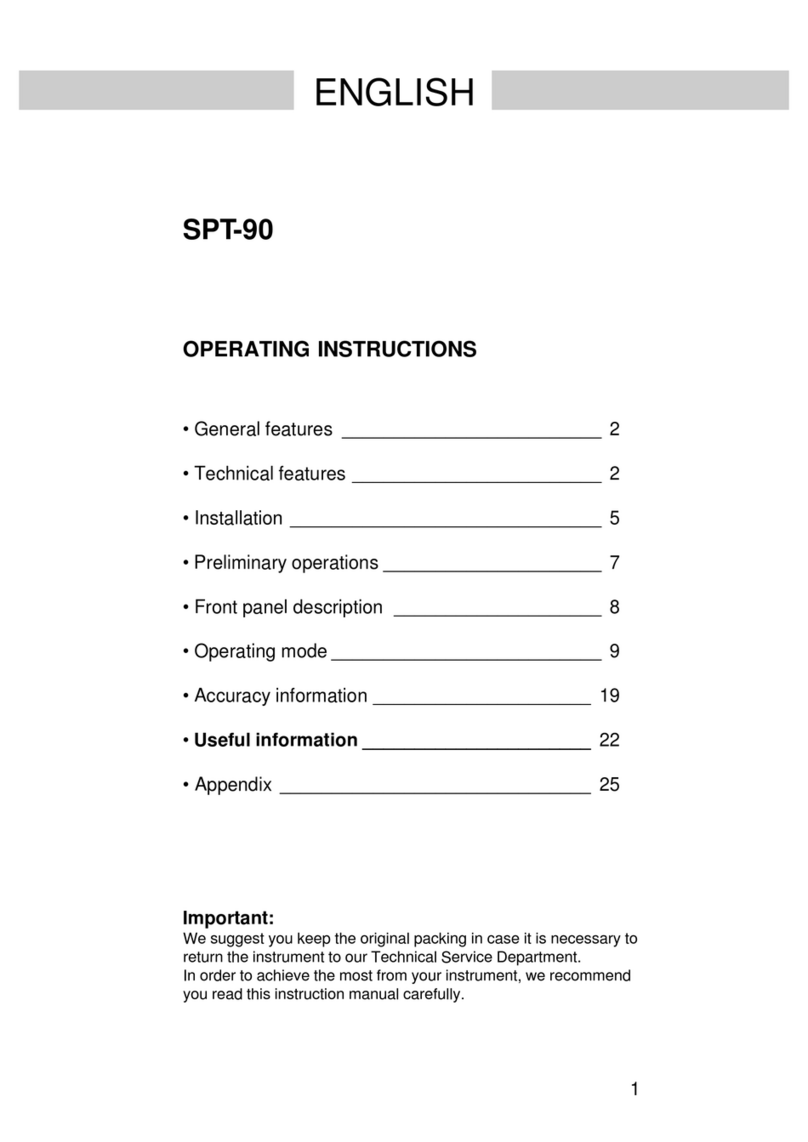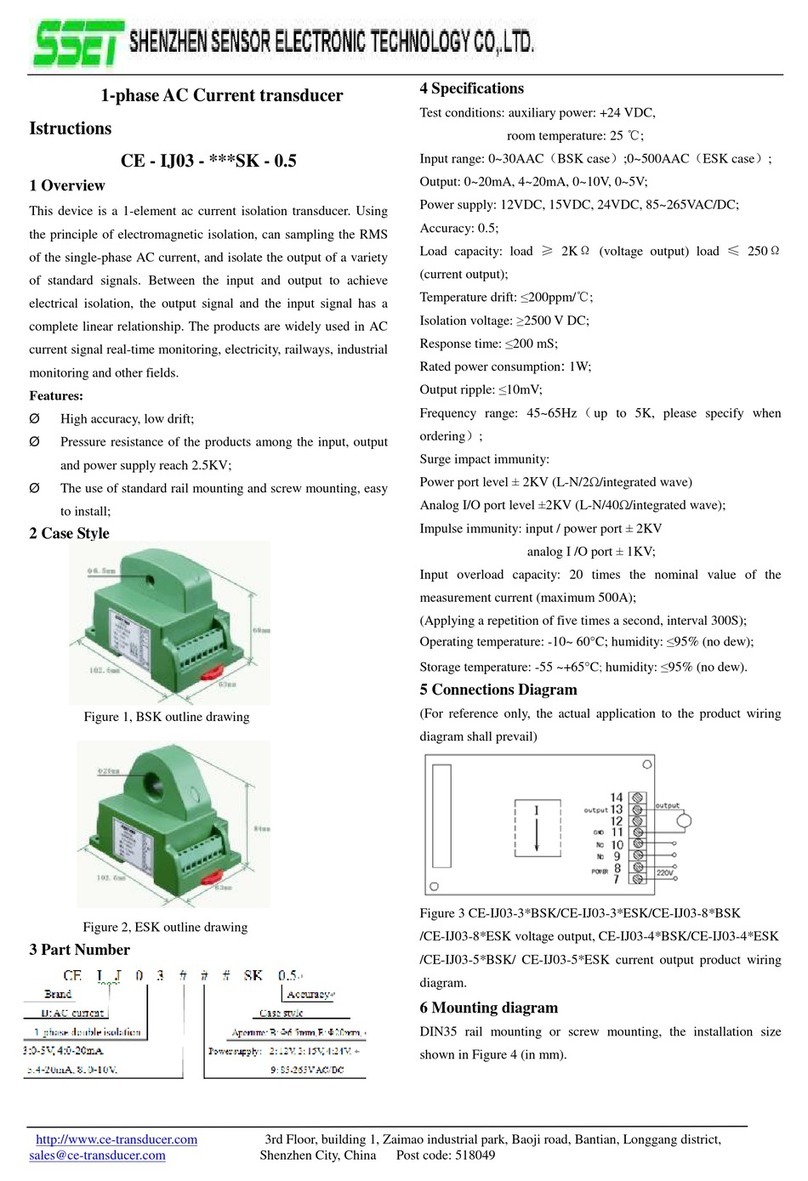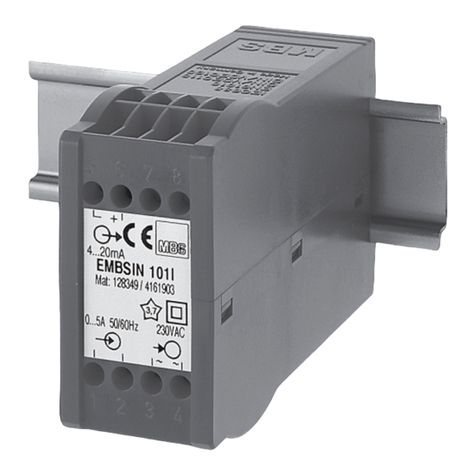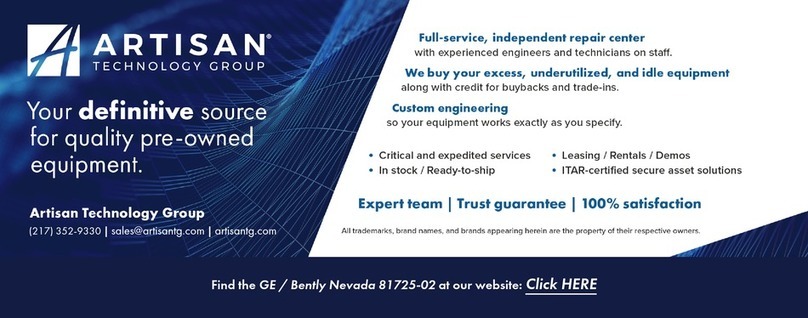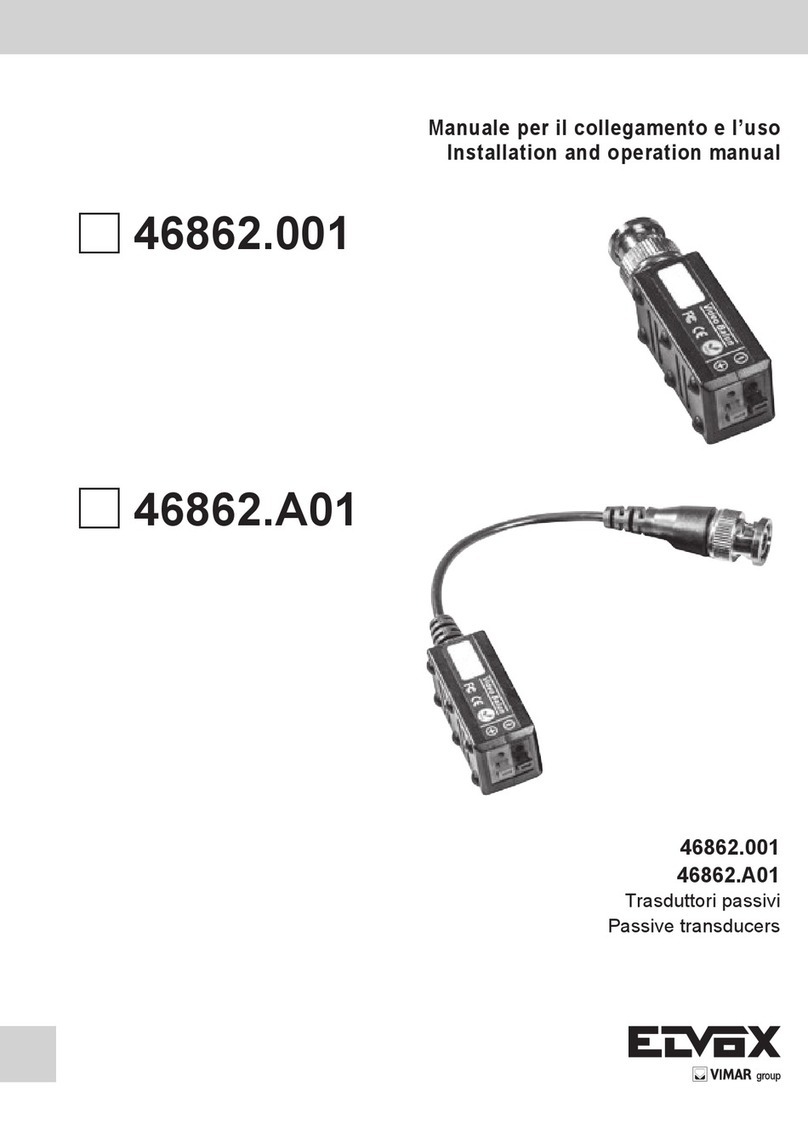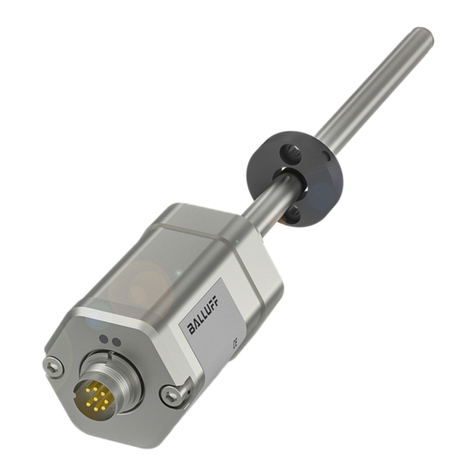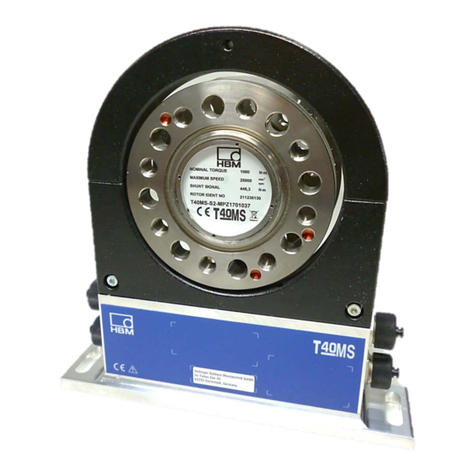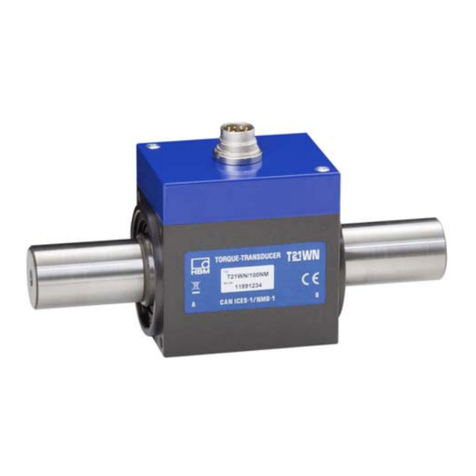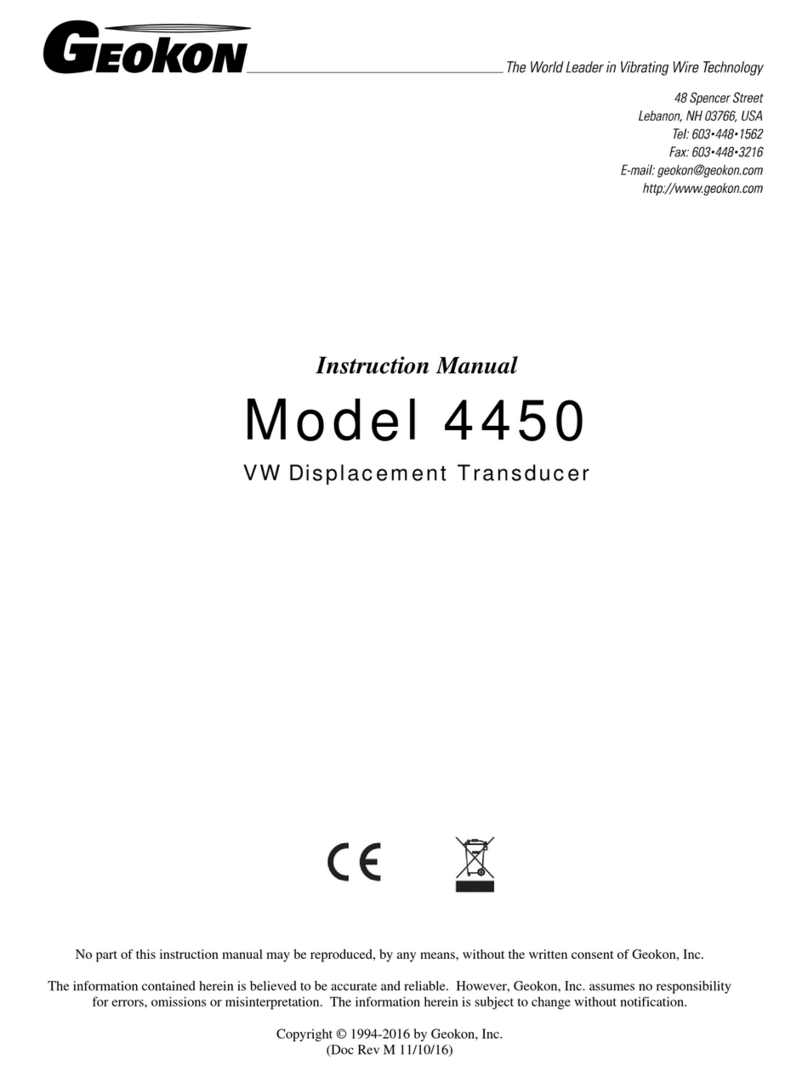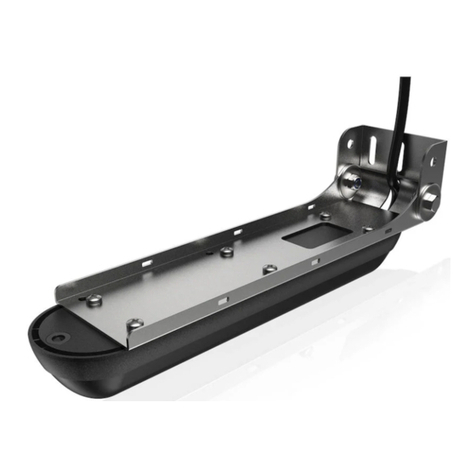FISCHER ME12 R Series User manual

II 3G Ex nA IIC T4 Gc
II 3D Ex tc IIIB T125°C Dc
Operating manual
ME12 ... R/S
Remotely configurable digital pressure transducer
for use in explosive areas
Gas explosion protection Zone 2
Dust explosion zone 22
09005483 • BA_EN_ME12_ATEX • Rev. ST4-D • 04/22
*09005483*

| Masthead FISCHER Mess- und Regeltechnik GmbH
2/24 BA_EN_ME12_ATEX
Masthead
Manufacturer: FISCHER Mess- und Regeltechnik GmbH
Bielefelderstr. 37a
D-32107 Bad Salzuflen
Telephone: +49 5222 974 0
Telefax: +49 5222 7170
eMail: [email protected]
web: www.fischermesstechnik.de
Technical editorial team: Documentation representative: T. Malischewski
Technical editor: R. Kleemann
All rights, also those to the translation, reserved. No part of this document may
be reproduced or processed, duplicated or distributed using electronic systems
or any other form (print, photocopy, microfilm or another process) without the
written consent of the company FISCHER Mess- und Regeltechnik GmbH, Bad
Salzuflen.
Reproduction for internal use is expressly allowed.
Brand names and procedures are used for information purposes only and do
not take the respective patent situation into account. Great care was taken
when compiling the texts and illustrations; Nevertheless, errors cannot be ruled
out. The company FISCHER Mess- und Regeltechnik GmbH will not accept any
legal responsibility or liability for this.
Subject to technical amendments.
© FISCHER Mess- und Regeltechnik GmbH 2015
Version history
Rev. ST4-A 09/15 Version 1 (first edition)
Rev. ST4-B 07/18 Version 2 (new ATEX classification)
Rev. ST4-C 12/18 Version 3 (correction accessories, connection cables)
Rev. ST4-D 04/22 Version 4 (UKCA Declaration of conformity)

FISCHER Mess- und Regeltechnik GmbH Table of Content
BA_EN_ME12_ATEX 3/24
Table of Content
1 Safety guidelines............................................................................................................. 4
1.1 General................................................................................................................................... 4
1.2 Personnel Qualification .......................................................................................................... 4
1.3 Risks due to Non-Observance of Safety Instructions............................................................. 4
1.4 Safety Instructions for the Operating Company and the Operator ......................................... 4
1.5 Unauthorised Modification...................................................................................................... 5
1.6 Inadmissible Modes of Operation........................................................................................... 5
1.7 Safe working practices for maintenance and installation work............................................... 5
1.8 Pictogram explanation............................................................................................................ 5
2 Product and functional description............................................................................... 6
2.1 Product overview.................................................................................................................... 6
2.2 Use as intended ..................................................................................................................... 7
2.3 Function diagram.................................................................................................................... 8
2.4 Design and mode of operation ............................................................................................... 8
3 Installation and assembly .............................................................................................. 9
3.1 Generalities ............................................................................................................................ 9
3.2 Process connection ................................................................................................................ 9
3.3 Electrical connections............................................................................................................. 11
3.4 Commissioning....................................................................................................................... 12
3.5 Servicing................................................................................................................................. 13
4 Technical data ................................................................................................................. 14
4.1 Generalities ............................................................................................................................ 14
4.2 Input variables ........................................................................................................................ 14
4.3 Output parameters ................................................................................................................. 15
4.4 Measurement accuracy .......................................................................................................... 15
4.5 Auxiliary energy ..................................................................................................................... 15
4.6 Application conditions............................................................................................................. 16
4.7 Parameters............................................................................................................................. 16
4.8 Construction design................................................................................................................ 17
5 Order Codes .................................................................................................................... 19
5.1 Accessories ............................................................................................................................ 21
6 Attachments .................................................................................................................... 22

1 | Safety guidelines FISCHER Mess- und Regeltechnik GmbH
4/24 BA_EN_ME12_ATEX
1 Safety guidelines
1.1 General
This operating manual contains basic instructions for the installation, operation
and maintenance of the device that must be followed without fail. It must be
read by the installer, the operator and the responsible specialist personnel be-
fore installing and commissioning the device.
This operating manual is an integral part of the product and therefore needs to
be kept close to the instrument in a place that is accessible at all times to the re-
sponsible personnel.
The following sections, in particular instructions about the assembly, commis-
sioning and maintenance, contain important information, non-observance of
which could pose a threat to humans, animals, the environment and property.
The instrument described in these operating instructions is designed and manu-
factured in line with the state of the art and good engineering practice.
1.2 Personnel Qualification
The instrument may only be installed and commissioned by specialized person-
nel familiar with the installation, commissioning and operation of this product.
Specialized personnel are persons who can assess the work they have been
assigned and recognize potential dangers by virtue of their specialized training,
their skills and experience and their knowledge of the pertinent standards.
For explosion-proof models the specialized personnel must have received spe-
cial training or instruction or be authorized to work with explosion-proof instru-
ments in explosion hazard areas.
1.3 Risks due to Non-Observance of Safety Instructions
Non-observance of these safety instructions, the intended use of the device or
the limit values given in the technical specifications can be hazardous or cause
harm to persons, the environment or the plant itself.
The supplier of the equipment will not be liable for damage claims if this should
happen.
1.4 Safety Instructions for the Operating Company and the
Operator
The safety instructions governing correct operation of theinstrument must be
observed. The operating company must make them available to the installation,
maintenance, inspection and operating personnel.
Dangers arising from electrical components, energy discharged by the medium,
escaping medium and incorrect installation of the device must be eliminated.
See the information in the applicable national and international regulations.
Please observe the information about certification and approvals in the Tech-
nical Data section.
The instrument must be decommissioned and secured against inadvertent re-
operationif a situation arises in which it must be assumed that safe operation is
no longer possible. Reasons for this assumption could be:
• evident damage to the instrument
• failure of the electrical circuits
• longer storage outside the approved temperature range.
• considerable strain due to transport
Repairs may be carried out by the manufacturer only.

FISCHER Mess- und Regeltechnik GmbH Safety guidelines | 1
BA_EN_ME12_ATEX 5/24
A professional single conformity inspection as per DIN EN 61010, section 1,
must be carried out before the instrument can be re-commissioned. This inspec-
tion must be performed at the manufacturer's location. Correct transport and
storage of the instrument are required.
1.5 Unauthorised Modification
Modifications of or other technical alterations to the instrument by the customer
are not permitted. This also applies to replacement parts. Only the manufacturer
is authorised to make any modifications or changes.
1.6 Inadmissible Modes of Operation
The operational safety of this instrument can only be guaranteed if it is used as
intended. The instrument model must be suitable for the medium used in the
system. The limit values given in the technical data may not be exceeded.
The manufacturer is not liable for damage resulting from improper or incorrect
use.
1.7 Safe working practices for maintenance and installation work
The safety instructions given in this operating manual, any nationally applicable
regulations on accident prevention and any of the operating company's internal
work, operating and safety guidelines must be observed.
The operating company is responsible for ensuring that all required mainten-
ance, inspection and installation work is carried out by qualified specialized per-
sonnel.
1.8 Pictogram explanation
DANGER
Type and source of danger
This indicates a direct dangerous situation that could lead to death or serious
injury (highest danger level).
1. Avoid danger by observing the valid safety regulations.
WARNING
Type and source of danger
This indicates a potentially dangerous situation that could lead to death or ser-
ious injury (medium danger level).
1. Avoid danger by observing the valid safety regulations.
CAUTION
Type and source of danger
This indicates a potentially dangerous situation that could lead to slight or seri-
ous injury, damage or environmental pollution (low danger level).
1. Avoid danger by observing the valid safety regulations.
NOTICE
Note / advice
This indicates useful information of advice for efficient and smooth operation.

2 | Product and functional description FISCHER Mess- und Regeltechnik GmbH
6/24 BA_EN_ME12_ATEX
2 Product and functional description
2.1 Product overview
The following provide an overview of the possible connectors and process con-
nections. The code stated corresponds to the respective code in the order code.
Electrical plug
Standard casing
Line socket
DIN EN 175 301-803-A
Circular plug connector M12
DIN EN 61076-2-101
(flanged connector)
Code H C
Fig.1: Electrical plug
Process connections
Code 87 88 85 P1
Code A3 A8
Near flush-mounted front sensor
G½ B ¼ -18 NPT EXT G¼ B Schrader ®
G1 B G¾ B
Fig.2: Process connections

FISCHER Mess- und Regeltechnik GmbH Product and functional description | 2
BA_EN_ME12_ATEX 7/24
2.1.1 Type plate
Order code
Technical data
Serial number
Connection diagram
Conformity ATEX marking
Type
Measuring range
Electr. output
Supply voltage.
Prod.-no.
Ex nA IIC T4 Gc
-10°C≤Tamb≤60°C
II 3G
Fig.3: Type plate
2.2 Use as intended
The ME12 is a pressure transmitter with a ceramic measuring cell for over-pres-
sure and under-pressure and can be used for both relative and also absolute
pressure measurements. The pressure transmitter can be used with non-ag-
gressive liquid and gaseous media. Please see the technical data for the re-
spective measuring ranges.
NOTICE
Soiled or aggressive media
Please contact the manufacturer before using this unit with dirty or aggressive
media because the unit needs to be adapted for the specific customer in terms
of the parts that come into contact with the media.
The device may only be used for the purpose stipulated by the manufacturer.
ATEX classification
Zone 22 ME12 pressure transmitters are suitable for use as 'Electrical equipment for use
in areas with combustible dust', zone 22 - dry dust.
The units are identified with
II 3D Ex tc IIIB T125°C Dc
Zone 2 ME12 pressure transmitters are suitable for use as 'Electrical equipment for use
in areas with combustible gases', zone 2.
The units are identified with
II 3G Ex nA IIC T4 Gc

2 | Product and functional description FISCHER Mess- und Regeltechnik GmbH
8/24 BA_EN_ME12_ATEX
2.3 Function diagram
Pressure pΔR
R
U/I U
Δ
b
out
1
2 3
4
5
Fig.4: Function diagram
1 Ceramic sensor 2 Electronics
3 Auxiliary energy 4 Electrical connection
5 Process connection
2.4 Design and mode of operation
The pressure sensor work on the thick layer technology DMS principle. The
measured pressure acts directly onto a ceramic membrane that deforms when
under pressure. This changes the resistance of the attached DMS bridge. Elec-
tronics integrated into the device convert this bridge signal into an electronic
output signal.
Every pressure transmitter is programmed according to the code in the order
code on delivery. Also, the electrical connections can be used to configure the
pressure transmitter, adapting it ideally to suit the process conditions. You will
need a Transmitter PC Interface available as an accessory.

FISCHER Mess- und Regeltechnik GmbH Installation and assembly | 3
BA_EN_ME12_ATEX 9/24
3 Installation and assembly
3.1 Generalities
The instrument may only be installed and commissioned by specialized person-
nel familiar with the installation, commissioning and operation of this product.
Specialized personnel are persons who can assess the work they have been
assigned and recognize potential dangers by virtue of their specialized training,
their skills and experience and their knowledge of the pertinent standards.
WARNING
Mounting pressure transmitters
During assembly, observe the respective national and international guidelines
and safety regulations.
Only mount the unit to systems that are depressurized. Only ever operate the
unit within the permitted measuring range or below the maximum overload.
Fig.5: Shutoff valve.
The device is set ex-works for vertical installation, however any installation posi-
tion is possible.
To guarantee safe working conditions during installation and maintenance, suit-
able stop valves must be fitted in the system (see accessories). By means of
the manometer shutoff, the unit
• Can be depressurized or taken out of operation.
• Be disconnected from the power supply within the applicable system for re-
pairs or inspections.
3.2 Process connection
• By authorized and qualified specialized personnel only.
• The pipes need to be depressurized when the instrument is being connec-
ted.
• Appropriate steps must be taken to protect the device from pressure surges.
• Check that the device is suitable for the medium being measured.
• Maximum pressures must be observed (cf. Tech. data)
WARNING
Earth connection via the system earth
During assembly, ensure that the earth connection between the unit and the
system earth is ensured. The connection to the system earth is realised via the
process connection. Therefore, never use an insulated Teflon tape or similar.
Design the process connection acc. to EN 837 and use a suitable flat seal.

3 | Installation and assembly FISCHER Mess- und Regeltechnik GmbH
10/24 BA_EN_ME12_ATEX
3.2.1 Measuring lines that need to be connected
The following points need to be observed when connecting the pressure line:
• To ensure there is no influence on the measured values, severe bends and
coils in the wire should be avoided.
• To prevent deposits, there should be a continuous incline or drop of at least
8%.
• When measuring steam pressure, a water bag-forming loop must be
provided due to the temperature (see accessories).
Round shape U-shape
G½
ca. 180
Ø20
56
155
ca. 200
G½
G½
ca. 275
ca. 130
Ø20
Ø56
G½
AF27
Manometer connection
Connection spigot
according to
DIN EN 837-1
Fig.6: Siphon MZ1###
• The transmitter must be positioned below the measuring point for liquid
measurements. Vent the pressure line before commissioning.
• The transmitter must be positioned above the measuring point for gas
measurements.
3.2.2 Pressure surge absorption
Pulsating pressure on the system side can lead to functional problems. We re-
commend installing a damping element in the pressure connection lines as a
protective measure.
a) Capillary throttle
Manometer connection
SW27 AF27
Connection spigot
according to DIN EN 837-1
305
110
G½
G½
Ø88
Ø4
Fig.7: Capillary throttle MZ400#

FISCHER Mess- und Regeltechnik GmbH Installation and assembly | 3
BA_EN_ME12_ATEX 11/24
b) Settable damping reactor
In operating mode, the damping throttle must be set so that the output signal
follows the pressure changes with a delay.
G½
G½
20
66
19
AF27
Setting screw
Connection spigot
according to DIN EN 837-1
Manometer connection
Fig.8: Damping reactor MZ410#
3.3 Electrical connections
• By authorized and qualified specialized personnel only.
• When connecting the unit, the national and international electro-technical
regulations must be observed.
• Disconnect the system from the mains, before electrically connecting the
device.
• Install the consumer-adapted fuses.
• Do not connect the connector if strained.
WARNING
Operation in areas at risk of explosion
If operated in explosive areas, the electrical data of the unit and the valid local
regulations and guidelines for the installation and operation of electrical systems
in explosive areas must be observed. (e.g. DIN EN 60079)
2-wire connection
Input signal
Supply
+Sig
-Sig
+Ub
-Ub
Output signal
Pressure Transmitter
Fig.9: 2-wire Circuitry

3 | Installation and assembly FISCHER Mess- und Regeltechnik GmbH
12/24 BA_EN_ME12_ATEX
3.3.1 Standardised plug DIN EN 175 301-803-A
1
3
2
Cable screw connection
M16x1.5
Seal NBR
Contact insert
Housing
Screw 1
2
3
Line socket Flanged connector
Fig.10: Line socket DIN EN 175 301-803-A
Ter-
minal
Signal name DC Cable colour
1 Supply /Output +Ub+Sig red
2 Supply /Output -Ub-Sig blue
3 n.c.
n.c.
Table1: 2-wire connection 4 ... 20 mA
The earth connection in the standardized plug is not connected.
3.3.2 M12 flanged connector DIN EN 61076-2-101
Coding A
1
43
21
4 3
2
Flanged
connector
Line socket
Fig.11: M12 plug DIN EN 61076-2-101
Pin Signal name DC Cable colour
1 Supply /Output +Ub+Sig brown
2 n.c.
3 Supply /Output -Ub-Sig blue
4 n.c.
Table2: 2-wire connection 4 ... 20 mA
3.4 Commissioning
All electrical supply, operating and measuring lines and the pressure connec-
tions must have been correctly installed before commissioning. All supply lines
are arranged so that there are no mechanical forces acting on the device.
• If liquid measuring media are used the pressure connection lines must be
vented, as liquid columns of different heights in the pipes can cause meas-
uring errors. The instrument must be protected against frost, if water is used
as a measuring medium.
• Appropriate shutoff valves must be provided to ensure safety during installa-
tion, maintenance and inspection

FISCHER Mess- und Regeltechnik GmbH Installation and assembly | 3
BA_EN_ME12_ATEX 13/24
3.5 Servicing
3.5.1 Maintenance
The instrument is maintenance-free. We recommend the following regular in-
spection to guarantee reliable operation and a long service life:
• Check the function in combination with downstream components.
• Check the leak-tightness of the pressure connection lines.
• Check the electrical connections.
The exact test cycles need to be adapted to the operating and environmental
conditions. In combination with other devices, the operating instructions for the
other devices also need to be observed.
3.5.2 Transport
The measuring device must be protected against impacts. It should be transpor-
ted in the original packaging or a suitable transport container.
3.5.3 Service
All defective or faulty devices should be sent directly to our repair department.
Please coordinate all shipments with our sales department.
WARNING
Process media residues
Process media residues in and ondismantled devices can be a hazard to
people, animals and the environment. Take adequate preventive measures. If
required, the devices must be cleaned thoroughly.
Return the device in the original packaging or a suitable transport container.
3.5.4 Accessories
• Prefabricated M12 connection lines (see Order Codes).
• Siphons MZ1###
• Capillary throttle coil MZ400#
• Settable damping reactor MZ410#
• Manometer shutoff valves MZ5###, MZ6###
Please see here the data sheet MZ measuring devices accessories. Here you
will find more detailed information about the technical data and the order codes
of the accessory parts MZ.
3.5.5 Disposal
Please help to protect the environment by always disposing of the work pieces
and packaging materials in compliance with the valid national waste and recyc-
ling guidelines or reuse them.

4 | Technical data FISCHER Mess- und Regeltechnik GmbH
14/24 BA_EN_ME12_ATEX
4 Technical data
4.1 Generalities
Reference conditions (acc. to IEC 61298-1)
Temperature error +15 … +25 °C
Relative humidity 45 … 75 %
Air pressure 86 … 106 kPa 860 … 1060 mbar
Auxiliary energy 24 V DC
Installation position User-defined
4.2 Input variables
Messgröße Pressure in non-aggressive liquid and gaseous media.
Relative pressure Measuring Pressure safety Characteristic
curve devi-
ation
[bar] [kPa] Overpressure Bursting
pressure
Option
0 … +0.6 0 ... 60 4 bar 7 bar ---
0 … +1 0 ... 100 4 bar 7 bar 0.5%FS
0 … +1,6 0 ... 160 4 bar 7 bar 0.5%FS
0 … +2.5 0 ... 250 10 bar 15 bar 0.5%FS
0 … +4 0 ... 400 10 bar 15 bar 0.5%FS
0 … +6 0 ... 600 20 bar 35 bar 0.5%FS
0 … +10 0 ... 1000 40 bar 70 bar 0.5%FS
0 … +16 0 ... 1600 40 bar 70 bar 0.5%FS
0 … +25 0 ... 2500 100 bar 150 bar ---
0 … +40 0 ... 4000 100 bar 150 bar ---
0 … +60 0 ... 6000 200 bar 250 bar ---
Absolutdruck Measuring Pressure safety Characteristic
curve devi-
ation
[bar] [kPa] Overpressure Bursting
pressure
Option
0 … +1 0 ... 100 4 bar 7 bar 0.5%FS
0 … +1.6 0 ... 160 4 bar 7 bar 0.5%FS
0 … +2.5 0 ... 250 10 bar 15 bar 0.5%FS
0 … +4 0 ... 400 10 bar 15 bar 0.5%FS
0 … +6 0 ... 600 10 bar 15 bar 0.5%FS
0 … +10 0 ... 1000 20 bar 35 bar 0.5%FS
0 … +16 0 ... 1600 20 bar 35 bar 0.5%FS

FISCHER Mess- und Regeltechnik GmbH Technical data | 4
BA_EN_ME12_ATEX 15/24
Vakuum und
± Measuringe
Measuring Pressure safety Characteristic
curve devi-
ation
[bar] [kPa] Overpressure Bursting
pressure
Option
0 … -1 0 ... -100 4 bar 7 bar ---
-1 … 0 -100 … 0 4 bar 7 bar ---
-1 … +0.6 -100 … +60 4 bar 7 bar ---
-1 … +1.5 -100 … +150 4 bar 7 bar ---
-1 … +3 -100 … +300 10 bar 15 bar ---
-1 … +5 -100 … +500 20 bar 35 bar ---
-1 … +9 -100 … +900 40 bar 70 bar ---
-1 … +15 -100 … +1500 40 bar 70 bar ---
-1 … +24 -100 … +2400 100 bar 150 bar ---
4.3 Output parameters
2-Conductor
Output range 4 … 20 mA
Limits ca. 26 mA
Apparent ohmic resist-
ance
(Ub-6V)/0.02A
4.4 Measurement accuracy
Non-linearity Maximum 0.5 % FS
Typical 0.2 % FS
Hysteresis Maximum 0.5 % FS
Typical 0.2 % FS
Characteristic curve deviation 2) Standard 1.0 %
Option 1) 0.5 %
Temperature drift Zero point 0.07 % FS/K
Measuring range 0.05 % FS/K
1) only possible for certain measuring ranges
2) incl. non-linearity and hysteresis
4.5 Auxiliary energy
2-Conductor
Rated Voltage 24 V DC
Admissible operating voltage 6 … 30 V DC
Power consumption ≤ 1 W

4 | Technical data FISCHER Mess- und Regeltechnik GmbH
16/24 BA_EN_ME12_ATEX
4.6 Application conditions
Ambient temperature range -10 °C … +70 °C
Storage temperature range -20 °C … +85°C
Medium temperature range -10 °C … +85 °C
ATEX EN 60079-0:2012 + A11:2013
EN 60079-15:2010
EN 60079-31:2014
EMV EN 61326-1:2013
EN 61326-2-3:2013
RoHS EN IEC 63000:2018
Protection type IP 65 acc. to EN 60529
Materials of the parts that come into contact with the surroundings
Housing CrNi Steel 1.4305
Device plug screw lid Polypropylene, black
Device plug Polyamide, brass, zinc
Cable socket Polyamide, polycarbonate, brass, zinc
Materials of the parts that come into contact with the measuring medium
Process connection CrNi Steel 1.4404
Sensor membrane Ceramic Al2O3
Seal 1) FKM Fluorinated rubber, Viton®
CR Chloroprene rubber, Neopren®
EPDM Ethylene propylene diene rubber
H-NBR Hydrogenated acrylonitrile butadiene rubber
FFPM Perfluorinated rubber, Kalrez®
1) see order code
4.7 Parameters
The ME12 pressure transmitter is fully configured on delivery, however it can
also be remotely configured on site. A PC, an interface, which is available as an
accessory and the PC software transmitter programmer are required for con-
figuration.
The EU13 with a USB interface is used for pressure transmitters with 2-line con-
nections.
The following parameters can be set
Characteristic curve Increasing / decreasing
Attenuation 0 … 200 s
Offset correction ±25 %FS
Margin correction ±25 %FS
Signal limits Current output
(settable)
Upper limit 3.5 … 22.5 mA
Lower limit 3.5 … 22.5 mA
Error signal 3.5 … 22.5 mA

FISCHER Mess- und Regeltechnik GmbH Technical data | 4
BA_EN_ME12_ATEX 17/24
4.8 Construction design
4.8.1 Dimensional picture
M12x1
72
Ø38.5
Ø28
SK (hex)
SW27
91
20
3
G½
Ø6
Ø17.5
13
2
Ø5
G¼
Ø9.5
Fig.12: Standard casing dimensional drawing
near flush-mounted front sensor
¼-18 NPT EXT Schrader ® G¾ B G1 B
¼-18 NPT
20
7.5
Ø2
7/16UNF
Ø21
Ø9 Ø9
15
15
G¾ G1
SW32 SW41
Fig.13: Process connections dimensional drawing

4 | Technical data FISCHER Mess- und Regeltechnik GmbH
18/24 BA_EN_ME12_ATEX
4.8.2 Process connection
Port Material
G½ B Connection shanks with external thread 1.4404
G¼ B Connection shanks with external thread 1.4404
¼-18 NPT EXT Connection shanks with external thread 1.4404
7/16 UNF Connection with inner thread for the
Schrader®- screw connection >
1.4404
G¾ B Connection shanks with external thread
near flush-mounted front sensor
1.4404
G1 B Connection shanks with external thread
near flush-mounted front sensor
1.4404
4.8.3 Electrical connection
Fig.14: Cable socket DIN EN
175 301-803A
Unit connector and cable socket DIN EN 175 301-803 Form A, 4 pin
1
3
21
2
3
cable socketUnit connector
1 2
2 wire
+ -
Sig
Ub
3
Fig.15: M12 coupling plug DIN
EN 61076-2-101
M12 flanged connector DIN EN 61076-2-101 coding A, 5 pin
coding A
1
4
3
22
flanged connector coupling plug
43
1
1234
+ -
Ub
Sig
5
5
5
2 wire

FISCHER Mess- und Regeltechnik GmbH Order Codes | 5
BA_EN_ME12_ATEX 19/24
5 Order Codes
Process connection
Output signal
Operating voltage
Casing
Seal (with contact
to medium)
Electrical connection
Verion
M E 1 2
Type
Measuring range
0
1 2 5 6 7 8 9 10 11 123 4Code No.
Measuring accuracy
13 14 15 16 17 18 19 20 21
9B 0
unused
Device specification
[1.2] Measuring range [1,2] Messbereich Abs. Rel.
01 0…0.6 bar F1 0 ... 60 kPa ●
02 0…1 bar F2 0 ... 100 kPa ● ●
03 0…1.6 bar F3 0 ... 160 kPa ● ●
04 0…2.5 bar F4 0 ... 250 kPa ● ●
05 0…4 bar F5 0 ... 400 kPa ● ●
06 0…6 bar F6 0 ... 600 kPa ● ●
07 0…10 bar F7 0 ... 1000 kPa ● ●
08 0…16 bar F8 0 ... 1600 kPa ● ●
09 0…25 bar G1 0 ... 2500 kPa ●
10 0…40 bar G2 0 ... 4000 kPa ●
11 0…60 bar G3 0 ... 6000 kPa ●
31 -1…0 bar ●
32 -1…0.6 bar ●
33 -1…1.5 bar ●
34 -1…3 bar ●
35 -1…5 bar ●
36 -1…9 bar ●
37 -1…15 bar ●
38 -1…24 bar ●
39 0…-1 bar ●
Abs. = Absolute pressure measurement
Rel. = relative pressure measurement.
[3] Measurement accuracy
M1.0 % Characteristic curve deviation
during relative pressure measurement
00.5 % Characteristic curve deviation
during relative pressure measurement
S1.0 % characteristic curve deviation
for absolute pressure measurement
T0.5 % characteristic curve deviation
for absolute pressure measurement

5 | Order Codes FISCHER Mess- und Regeltechnik GmbH
20/24 BA_EN_ME12_ATEX
[4.5] Process connection Material
85 Connection shanks with external thread G¼ B
1.4404
87 Connection shanks with external thread G½ B
88 Connecting port with outer thread ¼ -18 NPT EXT
P1 Schrader® screw connection inner thread 7/16 UNF
A3 Near flush-mounted front sensor outer thread G1 B
A8 Near flush-mounted front sensor outer thread G¾ B
[6] Output signal
B4 … 20 mA 2-wire version
[7] Electrical connection
HCable socket DIN EN 175 301-803
MM12 coupling device DIN EN
61076-2-101
[8] Operating voltage
924 V DC 2-wire version
[9] Casing Protection class (DIN EN 60
529)
0Standard casing
IP65
VStandard casing, cast version
FField casing, cast version
[10] Seal (with contact to medium)
VFKM Fluororubber, Viton®
CCR Chloroprene rubber (Neopren®)
EEPDM Ethylene propylene diene rubber
HH-NBR Hydrogenated acrylonitrile butadiene rubber
KFFPM Perfluorinated rubber (Kalrez®)
[11] Version
0Standard
[17] Device specification
SDust explosion protection Zone 22; dry dusts
RGas explosion protection zone 2, flammable gases
[18 … 21] Device specification
#### Ser. no. (Customer-specific model)
This manual suits for next models
1
Table of contents
Popular Transducer manuals by other brands
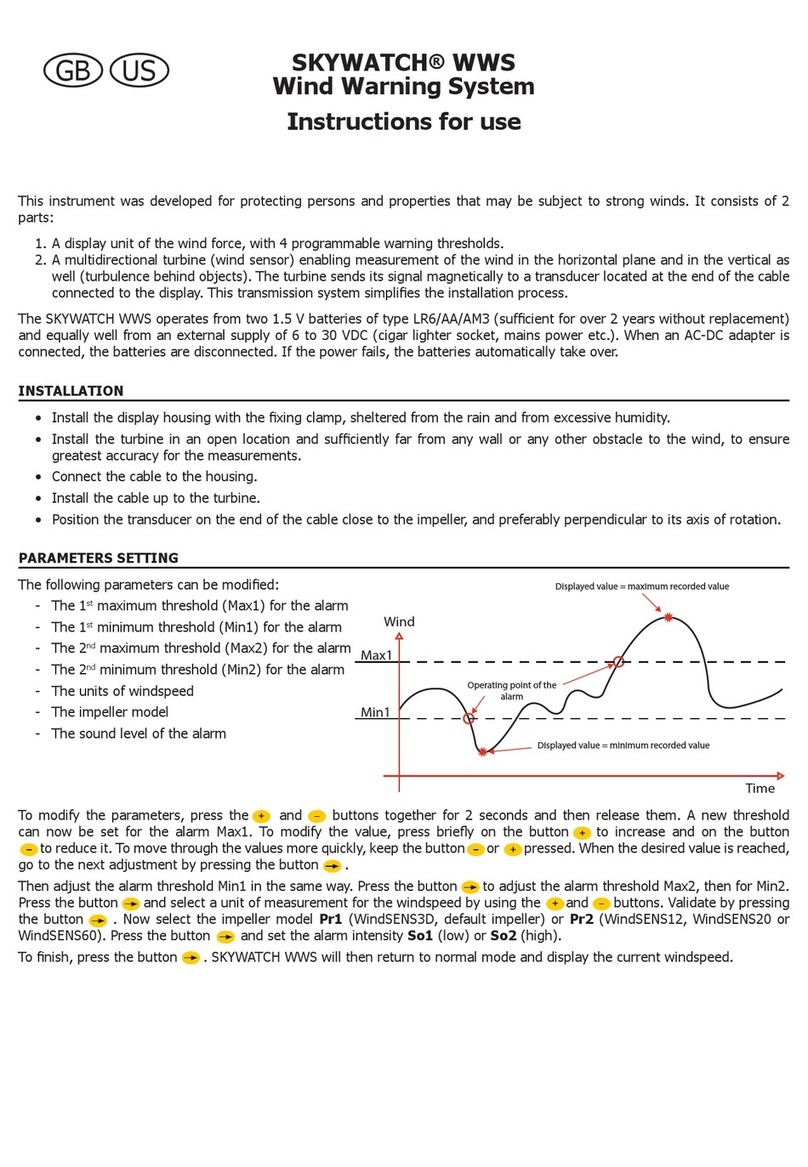
JDC Instruments
JDC Instruments SKYWATCH WWS Instructions for use

Veris Industries
Veris Industries PW Series installation guide
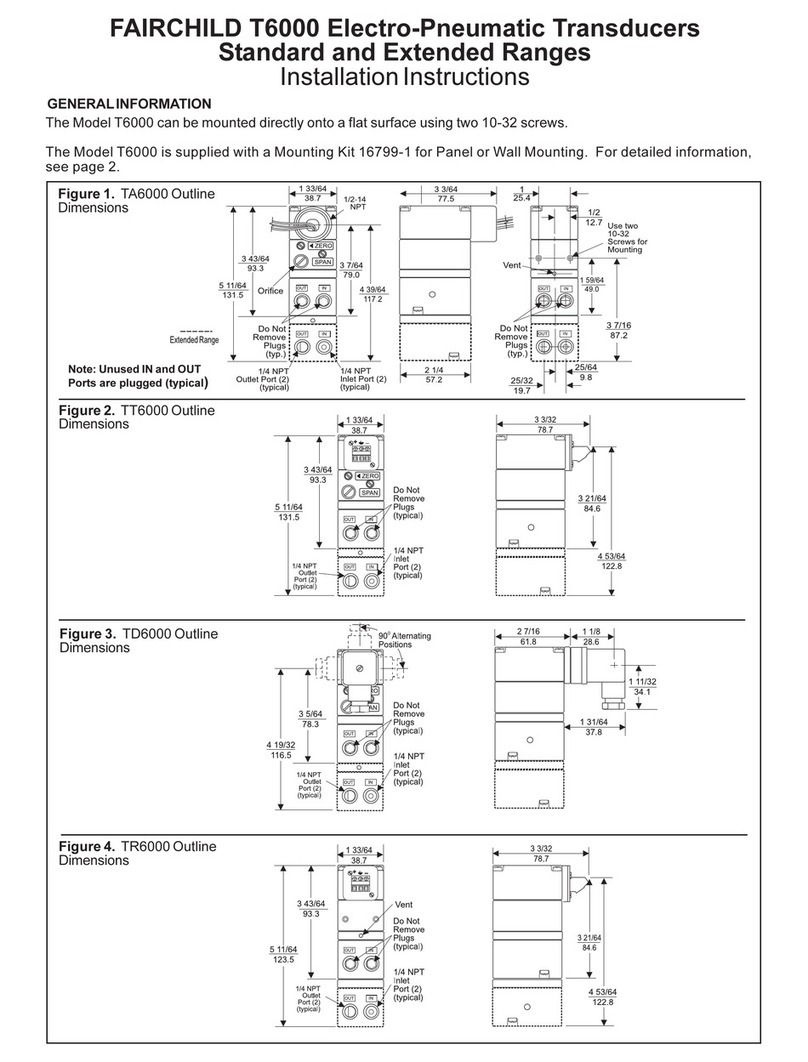
Fairchild
Fairchild T6000 installation instructions
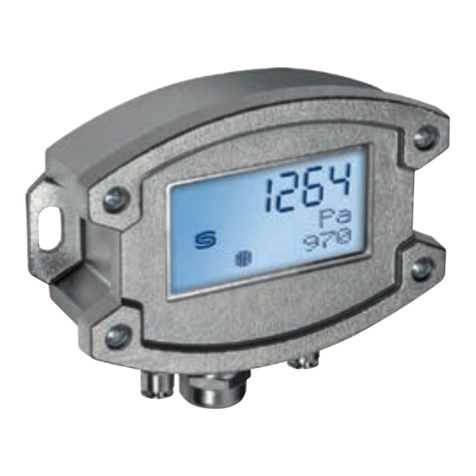
S+S Regeltechnik
S+S Regeltechnik PREMASREG 7100 VA ID Series Operating Instructions, Mounting & Installation

UIS
UIS WDT-110 user manual
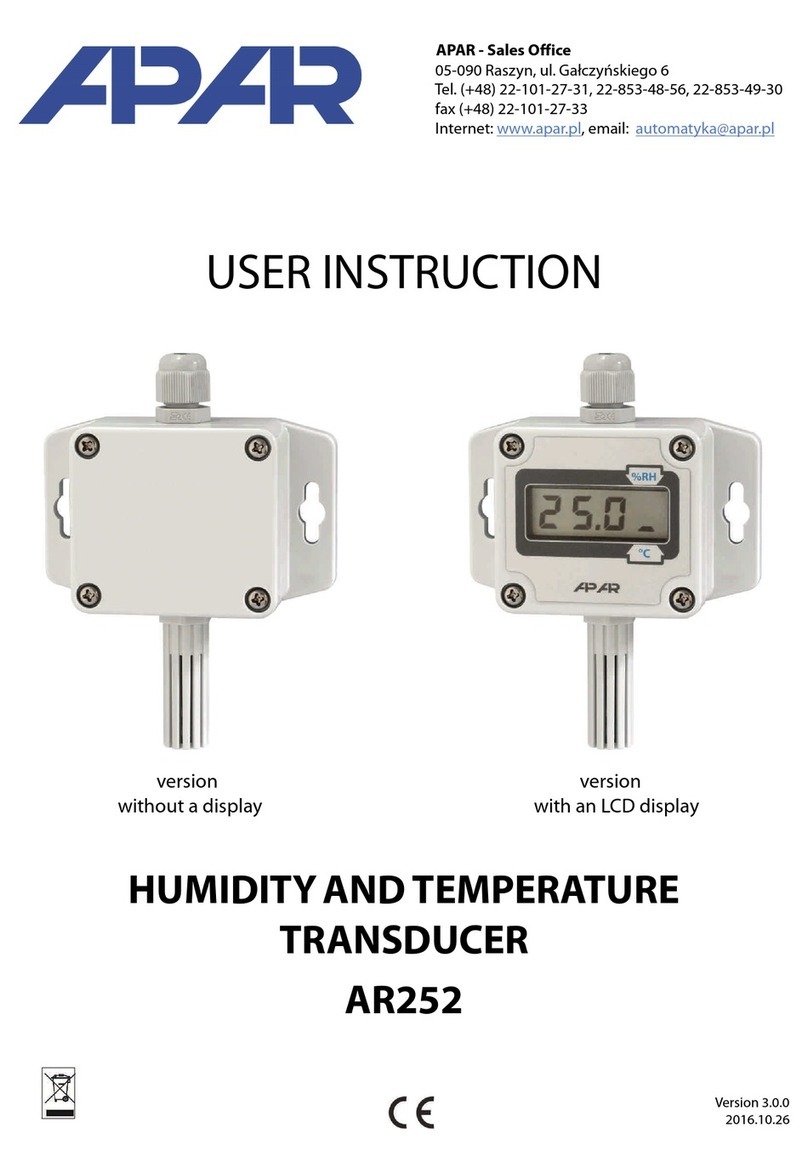
APAR
APAR AR252 User instruction
